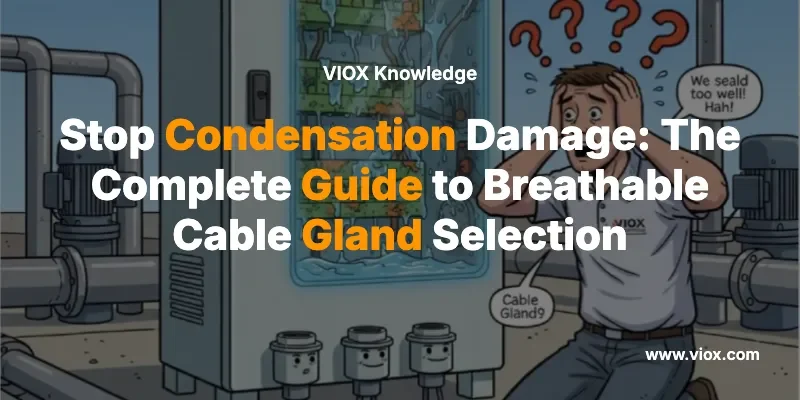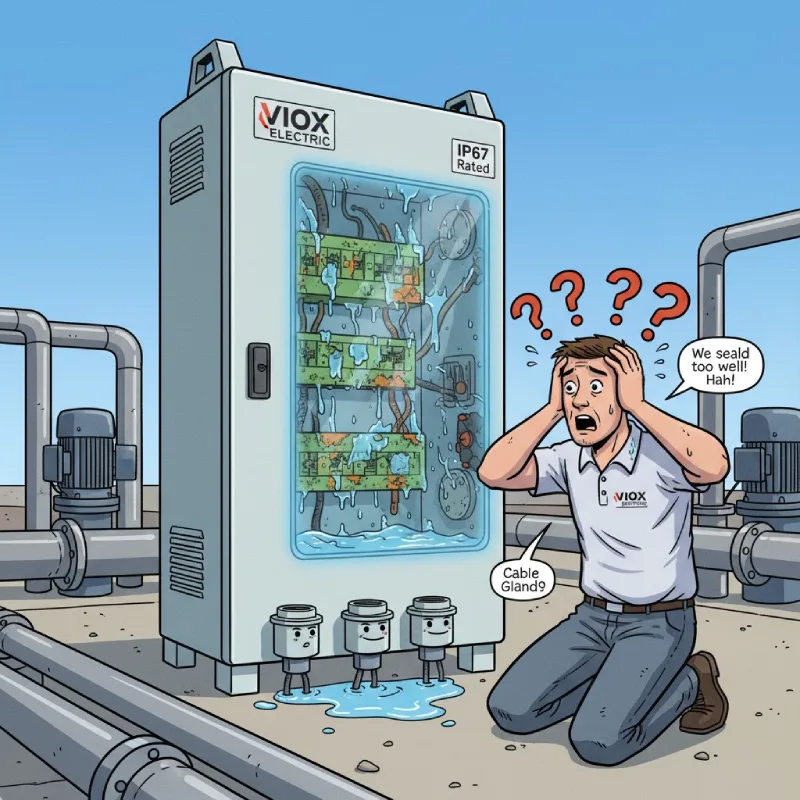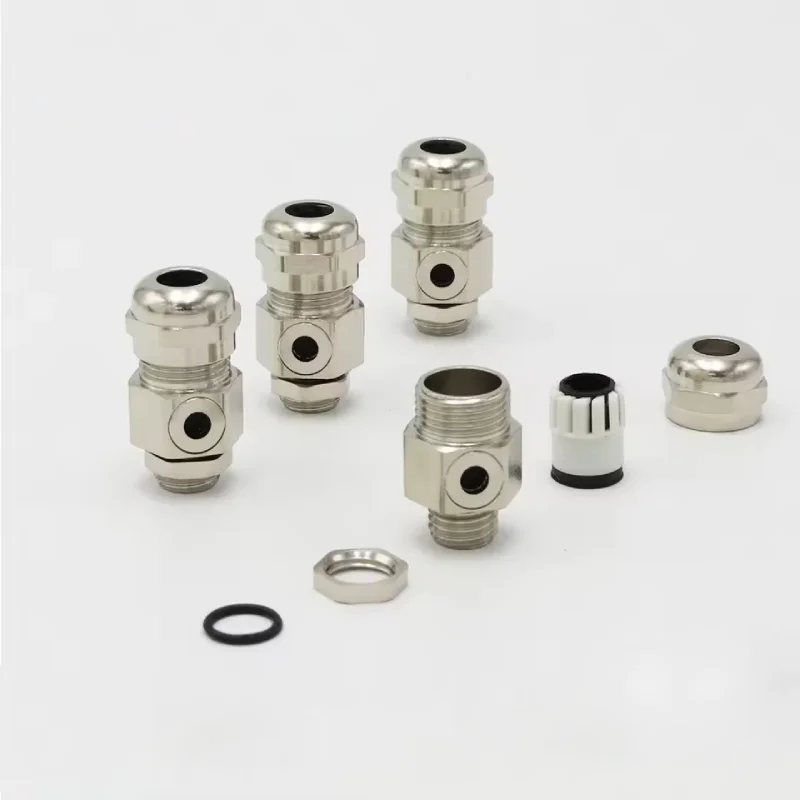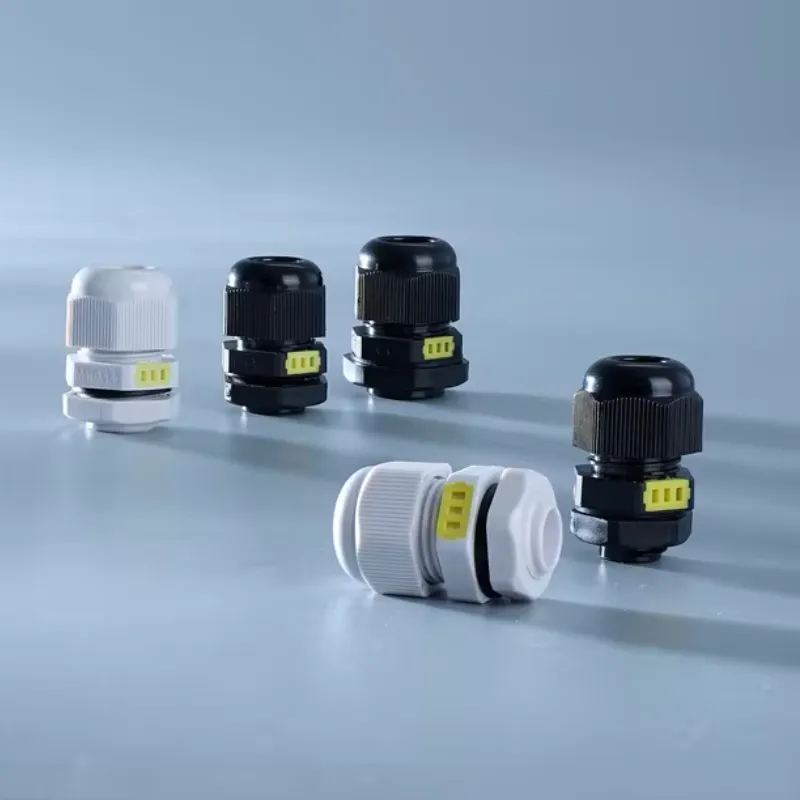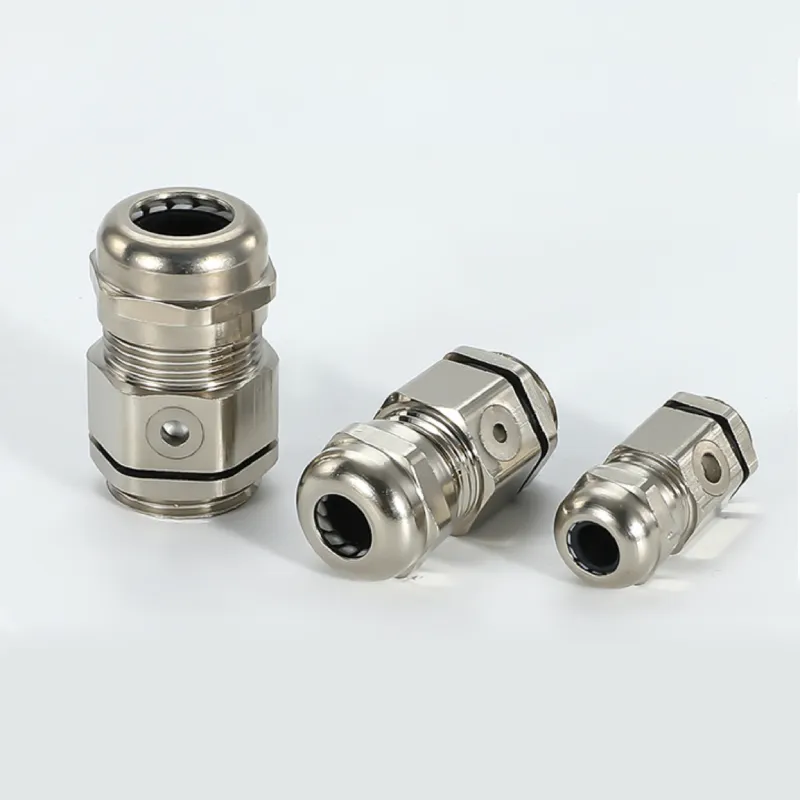The Waterproof Enclosure That Wasn’t
Picture this: You’ve just completed a critical outdoor electrical installation—a remote pump controller for a water treatment facility. The control panel is rated IP67, every cable gland is torqued to spec, and the entire system passes the sign-off inspection with flying colors. Your job is done, and the client is happy.
Six months later, you get an emergency call. The system is throwing intermittent faults. When maintenance opens the “waterproof” panel, they find a nightmare: green corrosion creeping across terminal blocks, moisture pooling at the enclosure bottom, and condensation beading on the inside of the polycarbonate cover. The panel never leaked—not a drop of rain got inside. So what went wrong?
Here’s the brutal truth: The real enemy wasn’t outside your enclosure. It was trapped inside. Your perfectly sealed cable glands created an airtight chamber that became a condensation factory, slowly destroying the very equipment they were meant to protect. This raises the critical question every engineer faces with outdoor or industrial installations: How do you seal cable entry points to keep water and dust out, while also preventing the deadly condensation buildup that corrodes equipment from the inside?
The answer is breathable cable glands—but only if you select them correctly.
Why “Waterproof” Enclosures Still Fail: The Physics You Can’t Ignore
The root cause is simple thermodynamics, but its effects are devastating. When an outdoor enclosure heats up during the day, the air inside expands. When night falls and temperatures drop, that air contracts, creating negative pressure inside the sealed box. This pressure differential has two destructive effects:
First, it can actually draw moisture into the enclosure through microscopic gaps in aging seals or around cable insulation—like a slow-motion vacuum pulling contamination inside. Second, even if your seal remains perfect, the air already trapped inside contains humidity. As the internal surfaces cool below the dew point, that invisible water vapor condenses into very visible—and very corrosive—liquid water on your terminals, circuit boards, and metal surfaces.
Think of it like leaving a cold drink on a table during summer. The glass doesn’t leak, but condensation appears on the outside because moisture in the surrounding air condenses on the cold surface. Inside your sealed enclosure, the same physics applies: temperature cycles create condensation on internal components. Standard cable glands, by creating a hermetic seal, trap this problem inside with nowhere to go.
This is why you see corrosion even in enclosures that never experienced external water ingress. The moisture was generated internally, and your “waterproof” installation became a terrarium for electrical failure.
The Breakthrough: Breathable Cable Glands That Breathe Without Leaking
VIOX elpojošs kabeļu ieliktnis
Breathable cable glands solve this paradox through elegant engineering: a microporous membrane that enables pressure equalization while maintaining waterproof integrity. Think of it as Gore-Tex for your electrical enclosure.
The technology works at the molecular level. The specialized venting membrane contains microscopic pores—typically 0.1 to 10 microns—that are large enough to allow air and water vapor molecules to pass through freely, equalizing internal and external pressure. However, these same pores are far too small for liquid water droplets (which are hundreds of times larger) or dust particles to penetrate. The result is a cable gland that simultaneously achieves:
- IP68 waterproof protection against external water and dust ingress
- Continuous air exchange that prevents internal pressure buildup
- Condensation prevention by allowing internal humidity to escape before it condenses
Galvenais secinājums: The breathable membrane isn’t a compromise between sealing and venting—it’s a precisely engineered filtration system that gives you both. But this only works if you select the right gland for your specific application.
The Three-Step Selection Framework: Choosing Your Breathable Cable Gland
Selecting the wrong breathable cable gland is almost worse than using a standard gland—you’ll have a false sense of security while condensation still damages your equipment. Follow this systematic approach to get it right the first time.
Step 1: Assess Your Environment and Condensation Risk Factors
Not every installation needs a breathable cable gland, and understanding your specific risk factors determines whether the investment is justified. Analyze these critical environmental conditions:
Temperature Fluctuation Severity: Daily temperature swings of 20°C or more create significant pressure cycling. Outdoor panels, rooftop installations, and desert climates are high-risk. If your enclosure experiences extreme day-night temperature differences, breathable glands aren’t optional—they’re mandatory.
Humidity Exposure: Coastal installations, irrigation control systems, wastewater treatment facilities, and tropical climates all subject enclosures to high ambient humidity. More moisture in the surrounding air means more moisture gets trapped inside during the heating cycle, which then condenses during cooling. High-humidity environments are prime candidates for breathable technology.
Installation Altitude and Pressure Changes: This is often overlooked. Enclosures installed on communications towers or mountain sites experience significant atmospheric pressure changes with weather fronts. A sealed enclosure at 2,000 meters altitude acts like a barometer, expanding and contracting with pressure changes—and creating condensation in the process.
Internal Heat Generation: Does your enclosure house VFDs, power supplies, or other heat-generating equipment? Internal heat sources create even more dramatic temperature cycles than ambient conditions alone. The equipment heats up during operation, then cools during off-periods—creating a condensation pump effect inside the enclosure.
Pro-Tip: If your enclosure checks two or more of these risk factors, standard cable glands are already failing you—you just haven’t opened the box to see the damage yet.
Step 2: Choose Your Material—The Nylon vs. Metal Decision
This is where engineers make expensive mistakes. The material selection isn’t about budget—it’s about matching thermal and chemical properties to your environment. Choose incorrectly, and the gland itself becomes the failure point.
Nylon PA66 (Polyamide) Breathable Glands
Vislabāk piemērots: General outdoor electrical installations, HVAC controls, standard industrial panels, irrigation systems, and any application where chemical exposure is minimal and temperatures stay below 100°C.
Material advantages: Excellent corrosion resistance (it’s plastic—it can’t corrode), good UV stability when properly formulated, lighter weight, and significantly lower cost than metal alternatives. PA66 nylon handles moisture exposure extremely well and is naturally resistant to most industrial contaminants.
Darba temperatūra: -40°C to +100°C continuous, with short-term excursions to 120°C. This covers 90% of outdoor electrical applications.
When to avoid: Chemical processing environments (nylon can degrade with certain solvents and acids), sustained high temperatures above 100°C, or applications where mechanical impact is a concern. Also avoid nylon in applications with extreme vibration—the plastic threads can fatigue over time.
Nickel-Plated Brass or Stainless Steel Breathable Glands
Vislabāk piemērots: Marine installations, chemical plants, refineries, high-temperature applications (boiler controls, furnace monitoring), food processing facilities requiring washdown, and anywhere mechanical robustness is critical.
Material advantages: Superior temperature rating (continuous operation to 120°C+), excellent mechanical strength, better vibration resistance, chemical resistance to most acids and solvents, and proven performance in harsh industrial environments.
Darba temperatūra: -40°C to +120°C continuous, with properly rated membranes handling even higher temperatures.
Trade-offs: Significantly higher cost (often 3-5x more than nylon), heavier weight, and the nickel plating or stainless construction is necessary to prevent corrosion—bare brass will corrode in marine environments just like any other metal.
Decision Matrix:
| Your Environment | Ieteicamais materiāls | Kāpēc |
|---|---|---|
| Standard outdoor panel, suburban/industrial location, temp fluctuations <40°C | Neilons PA66 | Cost-effective, proven reliability, adequate temp range |
| Coastal/marine installation within 1km of saltwater | Stainless steel or nickel-plated brass | Salt spray destroys nylon over time through UV + salt degradation |
| Chemical processing, exposure to solvents/acids | Nerūsējošais tērauds 316 | Chemical compatibility is non-negotiable |
| High-temperature application >100°C continuous | Nickel-plated brass or stainless | Nylon loses mechanical properties above 100°C |
| High-vibration environment (machinery mounted) | Metal construction | Better fatigue resistance in threads |
Galvenais secinājums: Don’t try to save $30 per gland in a marine environment by using nylon—you’ll spend $3,000 replacing corroded equipment in two years. Match the material to the environment’s harshest condition, not the average condition.
Step 3: Match Technical Specifications to Your Application Requirements
Even with the right material selected, improper sizing or specification mismatch will compromise your installation. This step ensures the gland actually performs as intended.
Cable Diameter Matching (Non-Negotiable)
Breathable cable glands must fit your cable’s outer diameter precisely. Too loose, and you lose mechanical retention and compromise the seal. Too tight, and you’ll compress the cable jacket during installation, potentially damaging conductors or the cable’s own water-blocking elements.
Critical specification: Measure your cable’s outer diameter with calipers—don’t estimate. Then consult the manufacturer’s cable compatibility chart. Most breathable glands use metric thread sizes (M12, M16, M20, M25, M32, M40) with corresponding cable diameter ranges:
- M12: 3-6.5mm cable diameter
- M16: 4-8mm cable diameter
- M20: 6-12mm cable diameter
- M25: 13-18mm cable diameter
- M32: 15-25mm cable diameter
- M40: 22-32mm cable diameter
These ranges overlap intentionally—select the size where your cable diameter falls in the middle third of the range for optimal sealing performance. If your cable is at the extreme end of a range, go to the next size up and use the compression seal to take up the difference.
IP Rating Validation
IP68 is the standard rating for breathable cable glands, indicating:
- IP6X (first digit): Complete dust-tight protection
- IPX8 (second digit): Protected against continuous immersion beyond 1 meter
However, the “8” designation doesn’t specify the exact depth or duration—this is defined by the manufacturer. Verify that the gland’s IP68 rating matches your installation requirements. Most quality breathable glands are tested to 5-10 meters water depth for 72 hours continuous submersion while maintaining the breathing function.
Pro-Tip: The IP rating is only valid if you install correctly. An IP68-rated gland installed with the wrong torque or without proper thread sealant (where specified) is really an IP20 waiting to fail.
Temperature Rating Match
Confirm that both the gland body AND the venting membrane are rated for your temperature range. Some low-cost breathable glands use a nylon body rated to 100°C but a membrane only rated to 80°C—the weak link limits your actual operating range.
For outdoor installations with direct sun exposure, remember that enclosure surface temperatures can exceed ambient by 30°C or more. An “80°C” gland might seem adequate for a 40°C ambient environment, but when the enclosure surface hits 70°C in full sun, you’re approaching failure conditions.
Venting Performance Specifications
This is the most technical aspect, but it’s what separates effective breathable glands from marketing gimmicks. Look for manufacturers who specify:
- Air flow rate: Typically measured in liters per minute at a specified pressure differential (e.g., “10 L/min at 70 mbar”). Higher flow rates mean better pressure equalization.
- Membrane material: ePTFE (expanded polytetrafluoroethylene) is the gold standard—it’s the same material used in Gore-Tex. Some manufacturers use PE (polyethylene) membranes, which work but have lower longevity.
- Membrane replacement: Can the venting membrane be replaced, or is the entire gland disposable? In critical applications, replaceable membranes allow maintenance without rewiring.
Installation Compatibility
Verify that your chosen gland is compatible with:
- Enclosure wall thickness: Most glands work with panels from 1-3mm thick, but some industrial applications use thicker metal enclosures
- Thread type: Metric ISO threads are standard in most of the world; NPT threads are common in North America
- Mounting hole size: Must match the gland’s thread OD—measure or drill correctly
Sertifikācijas prasības
For industrial installations, especially in hazardous locations, verify compliance with relevant standards:
- IEC standarti for international installations
- NEMA ratings for North American projects (NEMA Type 4X corresponds roughly to IP66)
- UL listings where required by electrical codes
- ATEX/IECEx certification for hazardous area installations (though breathable glands cannot be used in most explosive atmospheres—the venting membrane prevents pressure containment)
Galvenais secinājums: The cheapest breathable cable gland that meets your specifications isn’t a bargain if it fails six months into a five-year installation. Quality manufacturers provide detailed technical data sheets—if that information isn’t available, shop elsewhere.
Summary: Preventing Condensation Starts With Selection
By following this three-step framework, you can confidently specify breathable cable glands that actually solve your condensation problems instead of creating new ones. Let’s recap the critical decisions:
- ✓ Step 1 – Environment Assessment: Confirmed that temperature fluctuations, humidity, or internal heat generation create condensation risk worth solving
- ✓ Step 2 – Material Selection: Matched nylon vs. metal construction to your environment’s harshest chemical, temperature, and corrosion challenges
- ✓ Step 3 – Technical Specification: Precisely matched cable diameter, IP rating, temperature range, and venting performance to your application requirements
The engineering principle is straightforward: condensation forms when sealed enclosures trap moisture inside during temperature cycles. Breathable cable glands prevent this by enabling controlled air exchange while maintaining waterproof protection.
But here’s what separates successful installations from failures disguised as good ideas: disciplined specification. The wrong material in a corrosive environment, undersized cable diameter ranges, or inadequate temperature margins turn your breathable gland into an expensive standard gland—you paid more for technology that isn’t functioning.
Your next step: Before you order another standard cable gland for an outdoor or industrial enclosure, ask yourself: “What’s the cost of corrosion-related failure in this installation?” If six months of downtime, emergency service calls, and replacement equipment costs more than the modest price premium for breathable technology, the decision makes itself.
The maintenance technician who opens your panel two years from now will either find pristine equipment or corrosion damage. That outcome is determined right now—in the cable gland selection you make today.
Choose wisely. Engineer for the environment you have, not the environment you wish you had.

